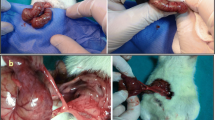Abstract
Background
Postsurgical adhesion formation is a common occurrence after most surgical procedures and is still a major cause of postoperative morbidity because no satisfactory treatment or prophylaxis has yet been developed. Further elucidation of the basic mechanisms of postsurgical adhesion formation is needed. Recent studies using germfree rats have found the indigenous bowel flora to be important in the adhesive response. The present study examined whether antibiotic treatment affects intra-abdominal adhesion formation.
Methods
Using the cecal crush model to inflict adhesions, groups of rats (n=12) were treated with placebo or amoxicillin/clavulanic acid in the drinking water. Treatment started 3 days before operation and continued until evaluation. Adhesion scores were recorded after 7 days. Bacterial counts were made from cultures of fecal samples on operation day and at termination.
Results
Amoxicillin/clavulanic acid decreased adhesion score compared to placebo. Adhesion incidence was 50% in the treatment group and 92% in the placebo group. Bacterial numbers were lower in the treatment group.
Conclusions
Antibiotic treatment which lowers bacterial numbers can decrease adhesions.

Similar content being viewed by others
References
diZerega GS (1994) Contemporary adhesion prevention. Fertil Steril 61:219–235
Menzies D (1992) Peritoneal adhesions: incidence, cause and prevention. In: Nyhus LM (ed) Surgery Annual Volume 24. Appleton & Lange, Norwalk, pp 24–45
Holmdahl L, Risberg B, Beck DE, Burns JW, Chegini N, diZerega GS, Ellis H (1997) Adhesions: pathogenesis and prevention. Eur J Surg 577 [Suppl]:56–62
Watson A, Lilford R (2000) Liquid and fluid agents for preventing adhesions after surgery for subfertility. Cochrane Database Syst Rev 2:CD001298
Farquhar C, Vandekerckhove P, Watson A, Vail A, Wiseman D (2000) Barrier agents for preventing adhesions after surgery for subfertility. Cochrane Database Syst Rev 2:CD000475
Liakakos T, Thomakos N, Fine PM, Dervenis C, Young RL (2001) Peritoneal adhesions: etiology, pathophysiology, and clinical significance. Recent advances in prevention and management. Dig Surg 18:260–273
Johns A (2001) Evidence-based prevention of post-operative adhesions. Hum Reprod Update 7:577–579
Chegini N (2001) Peritoneal molecular environment, adhesion formation and clinical implication. Front Biosci 7:91–115
Bothin C, Midtvedt T (1992) The role of the gastrointestinal micro flora in postsurgical adhesion formation—a study in germfree rats. Eur Surg Res 24:309–312
Bothin C, Okada M, Midtvedt T (1999) Postsurgical adhesion formation in germfree and exgermfree rats—a study using three scoring scales. J Invest Surg 12:147–150
Okada M, Bothin C, Blomhoff R, Kanazawa K, Midtvedt T (1999) Vitamin A deficiency impairs colonic healing but not adhesion formation in germfree and conventional rats. J Invest Surg 12:319–325
Bothin C, Okada M, Midtvedt T, Perbeck L (2001) The intestinal flora influences adhesion formation around surgical anastomoses. Br J Surg 88:143–145
Festing MFW (1979) Inbred strains in biomedical research. Macmillan, London
Videla S, Vilaseca J, Guarner F, Slas A, Treserra F, Crespo E, Antolin M, Malagelada J-R (1994) Role of intestinal microflora in chronic inflammation and ulceration of the rat colon. Gut 35:1090–1097
Swolin K (1966) Experimentelle Studien zur Prophylaxe von intraabdominalen Verwachsungen. Versuche an der Ratte mit einer Emulsion aus Lipid und Prednisolon. Acta Obstet Gynecol Scand 54:473–498
Oncel M, Kurt N, Remzi FH, Sensu SS, Vural S, Gezen CF, Cincin TG, Olcay E (2001) The effectiveness of systemic antibiotics in preventing postoperative, intraabdominal adhesions in an animal model. J Surg Res 101:52–55
Brolin J, Lahnborg G, Nord CE (1984) The effect of one prophylactic dosage of antibiotics on experimentally induced lethal intraabdominal sepsis. Acta Chir Scand 150:239–244
Rappaport WD, Holcomb M, Valente J, Chvapil M (1989) Antibiotic irrigation and the formation of intraabdominal adhesions. Am J Surg 158:435–437
Andrews CO, Gora ML (1994) Pleural effusions: pathophysiology and management. Ann Pharmacother 28:894–903
Senyigit A, Bayram H, Babaygit C, Topcu F, Balci AE, Satici O (2000) Comparison of the effectiveness of some pleural sclerosing agents for control of effusions in malignant pllural mesothelioma: a review of 117 cases. Respiration 67:623–629
Berg RD (1999) Bacterial translocation from the gastrointestinal tract. Adv Exp Med Biol 473:11–30
Levy J (2000) The effects of antibiotic use on gastrointestinal function. Am J Gastroenterol 95 [1 Suppl]:S8–S10
Holmdahl L, Ivarsson M-L (1999) The role of cytokines, coagulation, and fibrinolysis in peritoneal tissue repair. Eur J Surg 165:1012–1019
Toosie K, Gallego K, Stabile BE, Schaber B, French S, de Virgilio C (2000) Fibrin glue reduces intra-abdominal adhesions to synthetic mesh in a rat ventral hernia model. Am Surg 66:41–45
Jahoda AE, Albala DM, Dries DJ, Kovacs EJ (1999) Fibrin sealant inhibits connective tissue deposition in a murine model of peritoneal adhesion formation. Surgery 125:53–59
Eberhard T, Ullberg M, Sjöström I, Kronvall G, Wiman B (1995) Enhancement of t-PA-mediated plasminogen activation by bacterial surface receptors. Fibrinolysis 9:65–70
Virkola R, Lähteenmäki K, Eberhard T, Kuusela P, van Alphen L, Ullberg M, Korhonen TK (1996) Interaction of Haemophilus influenza with the mammalian extracellular matrix. J Infect Dis 173:1137–1147
Eberhard T, Kronvall G, Ullberg M (1999) Surface bound plasmin promotes migration of Streptococcus pneumoniae through reconstituted basement membranes. Microb Pathog 26:175–181
Echtenacher B, Weigl K, Lehn N, Männel DN (2001) Tumor necrosis factor- dependent adhesions as a major protective mechanism early in septic peritonitis in mice. Infect Immun 69:3550–3555
Acknowledgements
This study was supported by the Swedish Medical Research Council (no. 16X-06852) and the Karolinska Institute Funds.
Author information
Authors and Affiliations
Corresponding author
Rights and permissions
About this article
Cite this article
Bothin, C., Midtvedt, T. & Perbeck, L. Orally delivered antibiotics which lower bacterial numbers decrease experimental intra-abdominal adhesions. Langenbecks Arch Surg 388, 112–115 (2003). https://doi.org/10.1007/s00423-003-0369-3
Received:
Accepted:
Published:
Issue Date:
DOI: https://doi.org/10.1007/s00423-003-0369-3




